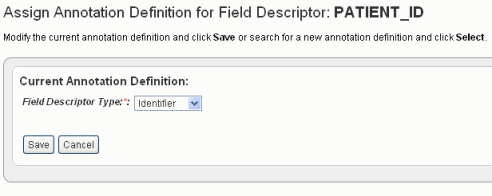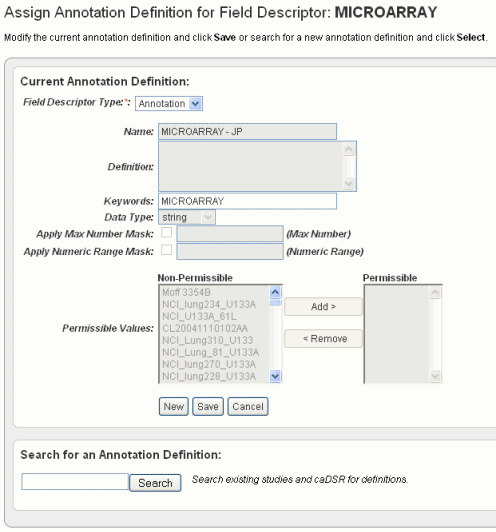 |
Page History
...
To continue creating a study or to modify a study, on the Edit Study page complete these steps:
- Enter or change (if editing) the name and/or description.
- Select or verify the checkbox to specify if you want to allow public access to the study.
- For the study log feature, click View Log or Edit Log. See #Study Log for details about the log.
- Click Save.
Info title Note You can save the study at any point in the process of creating it. You can resume the definition and deployment process later.
- If you choose to add a logo for the study, click the Browse button corresponding to Logo File in the upper right of the Edit Study page. Navigate for the file, and click Browse. The file type displays above the Upload Now button.
- Click the button to upload the logo. Once you save the study (or its edit), the logo displays in the center of the page. On the home page for the study, the logo displays in the upper left, above the sidebar.
...
One of the most important factors tasks in creating a study in caIntegrator is in properly annotating the data. Each annotation has a definition you must identify. Because the process can be quite complex, you might want to review the following steps for working with annotations.
...
- Add an annotation group. This optional step is for users who have a rigid data dictionary of all annotations relevant to the study. This step can also be helpful in cases where a study has many annotations. For more information, see #Adding an Annotation Group.
- Add subject annotation data. This consists of multiple sub-steps.
- Add a new subject annotation data sources file. This step uploads the file and starts the workflow for assigning uploaded data definitions. See #Editing an Annotation Group , step 1.
- Edit the annotations. This step opens the Define Fields for Subject Data page. See #Editing an Annotation Group, step 2.
- In the Define Fields for Subject Data page, review possible definitions in the annotation group associated with this study. See #Define Fields Page.
- Assign the visibility of each annotation definition. See #Editing an Annotation Group, step 2.
- Locate and verify the assignment as "identifier" for one annotation. See #Assigning an Identifier or Annotation.
- Review, verify and assign definitions for each annotation. You can do this in one of four ways:
--Accept existing default definitions as described in the associated annotation group. See #Assigning an Identifier or Annotation.
--Create or manage definitions manually. See #Assigning an Identifier or Annotation.
--Search for and use definitions existing in other caIntegrator studies. See #Searching for Annotation Definitions.
--Search for and use definitions from caDSR. See #Searching for Annotation Definitions.
- Load the Subject Annotation Source. Up until this point, you can periodically save your work with the annotations, but before you can deploy the study, you must complete this step.
- Deploy the study. See #Deploying the Study.S
Adding An Annotation Group
...
- For the column that you choose to be the one and only Identifier column (in this case, PatientID), in the Column Type drop-down list, select Identifier. The following figure shows the dialog box rendering when "identifier" is selected in the Field Descriptor Type drop-down list.
- Click Save to save the identifier. This returns you to the Define Fields for Subject Data page where the Identifier is noted in the Annotation Definition column.
- After you have defined which field is the Identifier, you must ensure that ALL other data fields also have an annotation definition assignment. For those fields without an annotation definition assignment or for those whose annotation definition you want to review, click Change Assignment.
- In the Assign Annotation Definition for Field Descriptor dialog box, shown in the following figure, select Annotation in the drop-down list.
As you select the column type, you can work with column headers in one of four ways in this dialog box.- You can accept existing default definitions (those that are inherent in the data file you selected). See Step 5.
- You can create and/or manage your own definitions manually. See Step 6.
- You can search for and use definitions in other caIntegrator studies. See #Searching for Annotation Definitions.
- You can search for and use definitions found in caDSR. See #Searching for Annotation Definitions.
- Review the current annotation definition in the Assign Definition page, Current Annotation Definition section. Click Cancel to return to the Define Fields... page.
You can still initiate a search for another annotation definition in the Search for an Annotation Definition section on the browser page if you choose to change the definition. See the following figure. See also #Searching for Annotation Definitions. Click Save to retain any changes. - To enter a new name annotation, or any other information about the annotation definition, click the New button and enter the information described in the following table.
Annotation Field
Field Description
Name
Enter the name for the annotation.
Definition
Enter the term(s) that define the annotation.
Keywords
Insert keyword(s) that could be used to find the annotation in a search, separated by commas.
Data Type
Select a string (default), numeric, or date.
Apply Max Number Mask
This field is available only for numeric-type annotations, or when a new definition is created. This feature is unavailable when permissible values are present.
Select the box and enter a maximum number for the mask, such as "80" for age. When you query results above the value of the mask, then the system displays the mask and not the actual age.
Note: If you enter masks of both "max number" and "range", caIntegrator applies both masks at the same time.
The Data Dictionary page now has a Restrictions column that shows restrictions whenever a mask has been applied.Apply Numeric Range Mask
This field is available only for numeric-type annotations, or when a new definition is created. This feature is unavailable when permissible values are present.
Select the box and enter a width of range for the mask, such as "5" representing blocks of 5 years. For example, if you enter a width of 5, the query only allows age blocks of 0-5, 6-10, 11-15, etc.
When you query results above the value of the mask, then the system displays the mask and not the actual age ranges.
Note: If you enter masks of both "max number" and "range", caIntegrator applies both masks at the same time.
The Data Dictionary page now has a Restrictions column that shows restrictions whenever a mask has been applied.Permissible/Non-permissible Values
Note: The first time you load a file, before you assign annotation definitions, step #3 in #Assigning An Identifier or Annotation, these panels may be blank. If the column header for the data is already "recognizable" by caIntegrator, the system makes a "guess" about the data type and assigns the values to the data type in the newly uploaded file. They will display in the Non-permissible values sections initially. Use the Add and Remove buttons to move the values shown from one list to the other, as appropriate.
...


